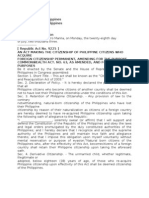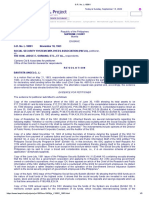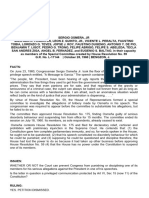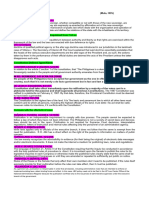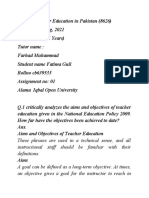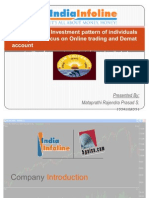The Three Quality Philosophies Compared
Uploaded by
Ramesh AlhatCopyright:
Available Formats
The Three Quality Philosophies Compared
Uploaded by
Ramesh AlhatOriginal Description:
Copyright
Available Formats
Share this document
Did you find this document useful?
Is this content inappropriate?
Copyright:
Available Formats
The Three Quality Philosophies Compared
Uploaded by
Ramesh AlhatCopyright:
Available Formats
Deming's 14-Point Philosophy
1. Create a constant purpose toward improvement.
Plan for quality in the long term.
Resist reacting with short-term solutions.
Don't just do the same things better – find better things to do.
Predict and prepare for future challenges, and always have the goal of
getting better.
2. Adopt the new philosophy.
Embrace quality throughout the organization.
Put your customers' needs first, rather than react to competitive
pressure – and design products and services to meet those needs.
Be prepared for a major change in the way business is done. It's about
leading, not simply managing.
Create your quality vision and implement it.
3. Stop depending on inspections.
Inspections are costly and unreliable – and they don't improve quality,
they merely find a lack of quality.
Build quality into the process from start to finish.
Don't just find what you did wrong – eliminate the "wrongs" altogether.
Use statistical control methods – not physical inspections alone – to
prove that the process is working.
4. Use a single supplier for any one item.
Quality relies on consistency – the less variation you have in the input,
the less variation you'll have in the output.
Look at suppliers as your partners in quality. Encourage them to spend
time improving their own quality – they shouldn't compete for your
business based on price alone.
Analyze the total cost to you, not just the initial cost of the product.
Use quality statistics to ensure that suppliers meet your quality
standards.
5. Improve constantly and forever.
Continuously improve your systems and processes. Deming promoted
the Plan-Do-Check-Act approach to process analysis and improvement.
Emphasize training and education so everyone can do their jobs better.
Use kaizen as a model to reduce waste and to improve productivity,
effectiveness, and safety.
6. Use training on the job.
Train for consistency to help reduce variation.
Build a foundation of common knowledge.
Allow workers to understand their roles in the "big picture."
Encourage staff to learn from one another and provide a culture and
environment for effective teamwork.
7. Implement leadership.
Expect your supervisors and managers to understand their workers and
the processes they use.
Don't simply supervise – provide support and resources so that each
staff member can do his or her best. Be a coach instead of a policeman.
Figure out what each person needs to do his or her best.
Emphasize the importance of participative management and
transformational leadership.
Find ways to reach full potential, and don't just focus on meeting targets
and quotas.
8. Eliminate fear.
Allow people to perform at their best by ensuring that they're not afraid
to express ideas or concerns.
Let everyone know that the goal is to achieve high quality by doing more
things right – and that you're not interested in blaming people when
mistakes happen.
Make workers feel valued and encourage them to look for better ways to
do things.
Ensure that your leaders are approachable and that they work with
teams to act in the company's best interests.
Use open and honest communication to remove fear from the
organization.
9. Break down barriers between departments.
Build the "internal customer" concept – recognize that each department
or function serves other departments that use their output.
Build a shared vision.
Use cross-functional teamwork to build understanding and reduce
adversarial relationships.
Focus on collaboration and consensus instead of compromise.
10. Get rid of unclear slogans.
Let people know exactly what you want – don't make them guess.
"Excellence in service" is short and memorable, but what does it mean?
How is it achieved? The message is clearer in a slogan like "You can do
better if you try."
Don't let words and nice-sounding phrases replace effective leadership.
Outline your expectations, and then praise people face-to-face for doing
good work.
11. Eliminate management by objectives.
Look at how the process is carried out, not just numerical targets.
Deming said that production targets encourage high output and low
quality.
Provide support and resources so that production levels and quality are
high and achievable.
Measure the process rather than the people behind the process.
12. Remove barriers to pride of workmanship.
Allow everyone to take pride in their work without being rated or
compared.
Treat workers the same, and don't make them compete with other
workers for monetary or other rewards. Over time, the quality system
will naturally raise the level of everyone's work to an equally high level.
13. Implement education and self-improvement.
Improve the current skills of workers.
Encourage people to learn new skills to prepare for future changes and
challenges.
Build skills to make your workforce more adaptable to change, and
better able to find and achieve improvements.
14. Make "transformation" everyone's job.
Improve your overall organization by having each person take a step
toward quality.
Analyze each small step and understand how it fits into the larger
picture.
Use effective change management principles to introduce the new
philosophy and ideas in Deming's 14 points.
Profound knowledge
William Edwards Deming indicates that every company – large or small,
serving or producing, profitable or non-profit – always deals with universal
knowledge. Deming calls this profound knowledge, which penetrates a
company from the outside. That leads to transformation, where the sitting
management needs to be open to.
According to William Edwards Deming, the system of profound knowledge is
made up of four components through which the world is looked at
simultaneously. These components function as lenses through which we see,
and all four are related to each other:
1. Valuing the system
2. The concept of variation and knowledge about this
3. Psychology
4. The theory of knowledge
Deming’s 14 points for Management
Deming’s 14 points for Management were first presented in his book Out of
the Crisis. With the 14 important management principles he offered a way to
drastically improve the a company’s effectiveness. Many of these
management principles are philosophical in nature, and some are more
programmatic.
All Deming’s 14 points for Management can bring about transformation.
Below you will find a short description of the 14 points:
1. Create constancy of purpose
Strive for constant improvement in products and services, with the aim of
becoming competitive and ensuring consistency in the way business is done,
which will ensure retention of employment. Do not just make adjustments at
the end of the production process, but evaluate if improvements are
necessary during the process and get started immediately.
2. The new philosophy
A new (economic) time offers new chances and challenges, and
management must take responsibility for being open to such changes.
Without change, a company can not sustain itself in a time when innovation
occurs every day.
3. Cease dependence on inspection
End the dependence on inspections and final checks to ensure quality. It is
better to that quality checks take place during the process so that
improvements can be made earlier. This section links back to the first point,
which promotes the importance of interim improvements.
4. End ‘lowest tender’ contract
Move towards a single supplier for any one item. Stop doing business and
negotiate with suppliers based on the lowest price. It is worthwhile in the
long term to build a good and long-standing relationship with suppliers,
which fosters trust and increases loyalty. An organisation should be able to
rely on their suppliers; they supply the parts for the production line and are
the first link to a high quality product.
5. Continually seek out problems
Improve constantly and forever. Continuous process improvement of
production and service results in improved quality and productivity, which in
turn leads to cost reduction. This part also relates to the first and third
points. Improved quality leads to less waste of other raw materials, which
subsequently has a cost-effective effect.
6. Institute training on the job
Training and development of employees is necessary for the survival of an
organisation. By integrating it into the organisation, it will be considered as
normal for the employees, as part of their Personal Development Plan.
7. Institute supervision
Adopt and institute leadership. Leadership needs to be stimulated. By
leading and supervising, managers are able to help employees and make
machines work better. Their helicopter view ensures that they can see
everything that happens on the workplace. They will also have to delegate
more tasks so that they can fully focus on the big picture.
8. Drive out fear
Fear is paralysing. Therefore, fear must be eliminated on the work floor so
that everyone can work effectively for the company, feel safe and take risks.
Transparent communication, motivation, respect and interest in each other
and each other’s work can contribute to this.
9. Break down barriers
By eliminating the boundaries between departments, cooperation can be
better and different expert teams will understand each other better. This can
be done by, for example, the creation of multifunctional teams, each with an
equal share and open to each other’s ideas.
10. Eliminate exhortations
Remove ‘stimulating’ slogans from the workplace. Such slogans, warnings
and exhortations are perceived as being patronising. Quality and production
problems do not arise from the individual employee, but from the system
itself.
11. Eliminate targets
No more focus on achieving certain margins; that impedes professionals
from performing their work well and taking the necessary time for it.
Rushing through the work can cause production errors. Managers should
therefore focus on quality rather than quantity.
12. Permit pride of workmanship
Let employees be proud of their craftsmanship and expertise again. This
relates back to the eleventh point. Employees feel more satisfaction when
they get a chance to execute their work well and professionally, without
feeling the pressure of deadlines.
13. Institute education
Integrate and promote training, self-development and improvement for each
employee. This directly connects to the sixth point. By encouraging
employees to work for themselves and to see their studies and training as a
self-evident part of their jobs, they are able to elevate themselves to a
higher level.
14. The transformation is everyone’s job
Transformation is the work of everyone. Set forth concrete actions to
implement and realise transformation and change throughout the
organisation.
You might also like
- Kenneth Shaleen Volume and Open Interest PDF67% (3)Kenneth Shaleen Volume and Open Interest PDF235 pages
- Executive Branch of The Philippine GovernmentNo ratings yetExecutive Branch of The Philippine Government52 pages
- Digest Assignment - de Guzman vs. COMELECNo ratings yetDigest Assignment - de Guzman vs. COMELEC3 pages
- Adoption and Effectivity of The Present Constitution100% (1)Adoption and Effectivity of The Present Constitution4 pages
- Republic of The Philippines Congress of The Philippines Metro Manila Twelfth Congress Third Regular SessionNo ratings yetRepublic of The Philippines Congress of The Philippines Metro Manila Twelfth Congress Third Regular Session3 pages
- 138 Osmeña vs. Pendatun 109 PHIL 863 (1960)No ratings yet138 Osmeña vs. Pendatun 109 PHIL 863 (1960)2 pages
- Pamatong vs. Comelec 427 Scra 96 (2004) FactsNo ratings yetPamatong vs. Comelec 427 Scra 96 (2004) Facts2 pages
- Jurisprudence, Concept and Philosophy of LawNo ratings yetJurisprudence, Concept and Philosophy of Law9 pages
- L. Acebedo Optical Vs CA. GR No. 100152. (March 31, 2000)No ratings yetL. Acebedo Optical Vs CA. GR No. 100152. (March 31, 2000)4 pages
- Facts History of Congressional Pork Barrel: Belgica vs. Executive Secretary Ochoa (Digest)No ratings yetFacts History of Congressional Pork Barrel: Belgica vs. Executive Secretary Ochoa (Digest)6 pages
- Article Xi: Accountability of Public OfficersNo ratings yetArticle Xi: Accountability of Public Officers23 pages
- Literal Interpretation: Adherence To, or Departure From, Language of StatuteNo ratings yetLiteral Interpretation: Adherence To, or Departure From, Language of Statute17 pages
- Case Digest Belgica V Executive SecretaryNo ratings yetCase Digest Belgica V Executive Secretary8 pages
- Legal Profession by Aquino, Et Al. (2017)No ratings yetLegal Profession by Aquino, Et Al. (2017)8 pages
- Total Quality Management - Deming's 14 PointsNo ratings yetTotal Quality Management - Deming's 14 Points3 pages
- Guidelines For Social Life Cycle Assessment of Products and Organizations 2020 22.1.21sml100% (1)Guidelines For Social Life Cycle Assessment of Products and Organizations 2020 22.1.21sml140 pages
- AAA - Review Notes & Tips Semester 2 2022No ratings yetAAA - Review Notes & Tips Semester 2 20226 pages
- 5caab3e21aed36128f707bf9 - RFP Response FormNo ratings yet5caab3e21aed36128f707bf9 - RFP Response Form11 pages
- Immediate download Catholic Social Thought Encyclicals and Documents from Pope Leo XIII to Pope Francis David J. O’Brien ebooks 2024100% (1)Immediate download Catholic Social Thought Encyclicals and Documents from Pope Leo XIII to Pope Francis David J. O’Brien ebooks 202467 pages
- SMEDA Wooden Furniture Manufacturing UnitNo ratings yetSMEDA Wooden Furniture Manufacturing Unit38 pages
- Itm 322 Human Resource Management Chapter 1 4No ratings yetItm 322 Human Resource Management Chapter 1 423 pages
- MODULE 1 Unit 2 Direct Current Generator and Motor Principles0% (1)MODULE 1 Unit 2 Direct Current Generator and Motor Principles21 pages
- Glorious Revolution, William and Mary IINo ratings yetGlorious Revolution, William and Mary II4 pages
- Story Analysing (Revisi) - Dzakirah & NadiniNo ratings yetStory Analysing (Revisi) - Dzakirah & Nadini5 pages
- Nurses Leading Primary Health Care: Delivering Quality, Serving Communities100% (1)Nurses Leading Primary Health Care: Delivering Quality, Serving Communities39 pages
- Analysis For All Poems in AQA Anthology Conflict ClusterNo ratings yetAnalysis For All Poems in AQA Anthology Conflict Cluster24 pages
- Adoption and Effectivity of The Present ConstitutionAdoption and Effectivity of The Present Constitution
- Republic of The Philippines Congress of The Philippines Metro Manila Twelfth Congress Third Regular SessionRepublic of The Philippines Congress of The Philippines Metro Manila Twelfth Congress Third Regular Session
- L. Acebedo Optical Vs CA. GR No. 100152. (March 31, 2000)L. Acebedo Optical Vs CA. GR No. 100152. (March 31, 2000)
- Facts History of Congressional Pork Barrel: Belgica vs. Executive Secretary Ochoa (Digest)Facts History of Congressional Pork Barrel: Belgica vs. Executive Secretary Ochoa (Digest)
- Literal Interpretation: Adherence To, or Departure From, Language of StatuteLiteral Interpretation: Adherence To, or Departure From, Language of Statute
- Guidelines For Social Life Cycle Assessment of Products and Organizations 2020 22.1.21smlGuidelines For Social Life Cycle Assessment of Products and Organizations 2020 22.1.21sml
- Immediate download Catholic Social Thought Encyclicals and Documents from Pope Leo XIII to Pope Francis David J. O’Brien ebooks 2024Immediate download Catholic Social Thought Encyclicals and Documents from Pope Leo XIII to Pope Francis David J. O’Brien ebooks 2024
- MODULE 1 Unit 2 Direct Current Generator and Motor PrinciplesMODULE 1 Unit 2 Direct Current Generator and Motor Principles
- Nurses Leading Primary Health Care: Delivering Quality, Serving CommunitiesNurses Leading Primary Health Care: Delivering Quality, Serving Communities
- Analysis For All Poems in AQA Anthology Conflict ClusterAnalysis For All Poems in AQA Anthology Conflict Cluster










